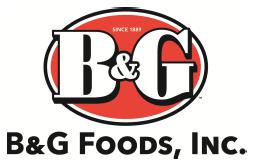
附件99.1

B&G食品 完成5.5億美元高級擔保票據的非公開發行
新澤西州帕西帕尼,2023年9月26日-B&G食品公司(紐約證券交易所代碼:BGS)今天宣佈,它已經完成了之前宣佈的本金總額5.5億美元、2028年到期的8.000優先擔保票據的發行,這筆交易免於根據修訂後的1933年證券法進行註冊。
優先擔保票據由B&G Foods的某些國內子公司在優先擔保的基礎上提供擔保 (為B&G Foods現有的優先擔保信貸協議和現有的優先無擔保票據提供擔保)。優先擔保票據以某些抵押品的優先擔保權益為擔保,這些抵押品通常包括B&G Foods的大部分以及擔保人對任何類型財產的權利或權益,但不動產和某些無形資產除外,該抵押品還為B&G Foods現有的 a的優先擔保信貸協議提供擔保平價通行證基礎。
B&G Foods打算將此次發行的淨收益與手頭現金一起用於贖回B&G Foods 2025年到期的5.25%優先票據本金總額5.554億美元,並支付 相關費用和支出。
優先擔保票據及相關擔保僅提供予 依據證券法第144A條規則豁免註冊的合資格機構買家,以及依據證券法S規則進行美國境外交易的若干非美國人士。高級擔保票據和相關擔保沒有也不會根據證券法、任何州證券法或任何其他司法管轄區的證券法進行登記。因此,如果沒有《證券法》和任何州或其他司法管轄區的任何適用證券法的登記要求或適用的豁免,優先擔保票據和相關擔保不得在美國發售或出售。
本新聞稿不構成關於2025年到期的5.25%優先票據的贖回通知,也不構成出售或邀請購買優先擔保票據和相關擔保的要約,也不會在任何州或司法管轄區 出售優先擔保票據和相關擔保, 在任何州或司法管轄區,此類要約、募集或出售在根據任何此類 州或司法管轄區的證券法註冊或資格之前是非法的。
關於B&G食品公司
總部設在新澤西州帕西帕尼的B&G Foods及其子公司 在美國、加拿大和波多黎各生產、銷售和分銷高質量、品牌穩定的冷凍食品。 B&G Foods擁有您知道和喜愛的50多個品牌的多樣化組合,包括B&G, B&M, 熊溪, 小麥奶油, Crisco, 破折號, 綠色巨人, 拉斯帕爾馬斯, 勒蘇爾, Mama Mary’s, Maple Grove Farms, New York Style, Ortega, Polaner, Spice Islands and Victoria, there’s a little something for everyone.
Forward-Looking Statements
Statements in this press release that are not statements of historical or current fact constitute “forward-looking statements.” The forward-looking statements contained in this press release include, without limitation, statements related to B&G Foods’ intended use of proceeds of the senior secured notes offering, including the redemption of a portion of the 5.25% senior notes due 2025. Such forward-looking statements involve known and unknown risks, uncertainties and other unknown factors that could cause the actual results of B&G Foods to be materially different from the historical results or from any future results expressed or implied by such forward-looking statements. In addition to statements that explicitly describe such risks and uncertainties, readers are urged to consider statements labeled with the terms “believes,” “belief,” “expects,” “projects,” “intends,” “anticipates,” “assumes,” “could,” “should,” “estimates,” “potential,” “seek,” “predict,” “may,” “will” or “plans” and similar references to future periods to be uncertain and forward-looking. Factors that may affect actual results include, without limitation: the Company’s substantial leverage; the effects of rising costs for and/or decreases in supply of the Company’s commodities, ingredients, packaging, other raw materials, distribution and labor; crude oil prices and their impact on distribution, packaging and energy costs; the Company’s ability to successfully implement sales price increases and cost saving measures to offset any cost increases; intense competition, changes in consumer preferences, demand for the Company’s products and local economic and market conditions; the Company’s continued ability to promote brand equity successfully, to anticipate and respond to new consumer trends, to develop new products and markets, to broaden brand portfolios in order to compete effectively with lower priced products and in markets that are consolidating at the retail and manufacturing levels and to improve productivity; the ability of the Company and its supply chain partners to continue to operate manufacturing facilities, distribution centers and other work locations without material disruption, and to procure ingredients, packaging and other raw materials when needed despite disruptions in the supply chain or labor shortages; the impact pandemics or disease outbreaks, such as the COVID-19 pandemic, may have on the Company’s business, including among other things, the Company’s supply chain, manufacturing operations or workforce and customer and consumer demand for the Company’s products; the Company’s ability to recruit and retain senior management and a highly skilled and diverse workforce at the Company’s corporate offices, manufacturing facilities and other locations despite a very tight labor market and changing employee expectations as to fair compensation, an inclusive and diverse workplace, flexible working and other matters; the risks associated with the expansion of the Company’s business; the Company’s possible inability to identify new acquisitions or to integrate recent or future acquisitions or the Company’s failure to realize anticipated revenue enhancements, cost savings or other synergies from recent or future acquisitions; the Company’s ability to successfully complete the integration of recent or future acquisitions into the Company’s enterprise resource planning (ERP) system; tax reform and legislation, including the effects of the Infrastructure Investment and Jobs Act, U.S. Tax Cuts and Jobs Act and the U.S. CARES Act, and future tax reform or legislation; the Company’s ability to access the credit markets and the Company’s borrowing costs and credit ratings, which may be influenced by credit markets generally and the credit ratings of the Company’s competitors; unanticipated expenses, including, without limitation, litigation or legal settlement expenses; the effects of currency movements of the Canadian dollar and the Mexican peso as compared to the U.S. dollar; the effects of international trade disputes, tariffs, quotas, and other import or export restrictions on the Company’s international procurement, sales and operations; future impairments of the Company’s goodwill and intangible assets; the Company’s ability to protect information systems against, or effectively respond to, a cybersecurity incident, other disruption or data leak; the Company’s ability to successfully implement the Company’s sustainability initiatives and achieve the Company’s sustainability goals, and changes to environmental laws and regulations; and other factors that affect the food industry generally, including: recalls if products become adulterated or misbranded, liability if product consumption causes injury, ingredient disclosure and labeling laws and regulations and the possibility that consumers could lose confidence in the safety and quality of certain food products; competitors’ pricing practices and promotional spending levels; fluctuations in the level of the Company’s customers’ inventories and credit and other business risks related to the Company’s customers operating in a challenging economic and competitive environment; and the risks associated with third-party suppliers and co-packers, including the risk that any failure by one or more of the Company’s third-party suppliers or co-packers to comply with food safety or other laws and regulations may disrupt the Company’s supply of raw materials or certain finished goods products or injure the Company’s reputation. The forward-looking statements contained herein are also subject generally to other risks and uncertainties that are described from time to time in B&G Foods’ filings with the Securities and Exchange Commission, including under Item 1A, “Risk Factors” in the Company’s most recent Annual Report on Form 10-K and in its subsequent reports on Forms 10-Q and 8-K. Investors are cautioned not to place undue reliance on any such forward-looking statements, which speak only as of the date they are made. B&G Foods undertakes no obligation to publicly update or revise any forward-looking statement, whether as a result of new information, future events or otherwise.
Contacts:
| Investor Relations: ICR, Inc. Dara Dierks 866.211.8151 |
Media Relations: ICR, Inc. Matt Lindberg 203.682.8214 |